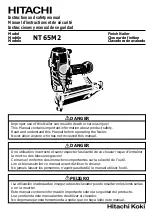
4
GENERAL SAFETY RULES
Safety is a combination of common sense, staying alert, and knowing how your brad nailer works.
SAVE THESE SAFETY INSTRUCTIONS
.
WARNING:
Do not operate this unit until you read this instruction manual for safety,
operation and maintenance instructions.
WARNING:
This product contains chemicals known to the State of California to cause
cancer, and birth defects or other reproductive harm.
Wash hands after handling.
WARNING:
Some dust contains chemicals known to the State of California to cause
cancer, birth defects or other reproductive harm such as asbestos and lead in lead based paint.
Actuating tool may result in flying debris, collation material, or dust which could harm operator’s
eyes.
The operator and all those persons in the general area should wear safety glasses with permanently
attached side shields. Approved safety glasses are imprinted with the characters “Z87.1”. It is the
employer’s responsibility to enforce the use of eye protection equipment by the tool operator and other
people in the work area.
Always wear appropriate personal hearing and other protection during use.
Under some conditions
and duration of use, noise from this product may contribute to hearing loss.
Use only clean, dry, regulated air.
Condensation from an air compressor can rust and damage the
internal workings of the tool.
Regulate air pressure. Use air pressure compatible with ratings on the nameplate of the tool.
(Not
to exceed 110 psi) Do not connect the tool to a compressor rated at over 200 psi. The tool operating
pressure must never exceed 200 psi even in the event of regulator failure.
Only use air hose that is rated for a maximum working pressure of at least 150 PSI or 150% of the
maximum system pressure, which ever is greater.
Do not use bottled gases to power this tool.
Bottled compressed gases such as oxygen, carbon dioxide,
nitrogen, hydrogen, propane, acetylene or air are not for use with pneumatic tools. Never use combustible
gases or any other reactive gas as a power source for this tool. Danger of explosion and/or serious
personal injury may result.
Use couplings that relieve all pressure from the tool when it is disconnected from the power supply.
Use hose connectors that shut off air supply from compressor when the tool is disconnected.
Disconnect tool from air supply when not in use. Always disconnect tool from air supply and
remove fasteners from magazine before leaving the area or passing the tool to another operator.
Do not carry tool to another work area in which changing location involves the use of scaffoldings,
stairs, ladders, and the like, with air supply connected. Do not make adjustments, remove
magazine, perform maintenance or clear jammed fasteners while connected to the air supply.
If the
Содержание PS6130
Страница 2: ...2...
Страница 14: ...14 EXPLODED VIEW PARTS LIST...


































